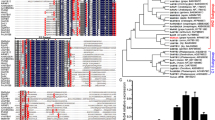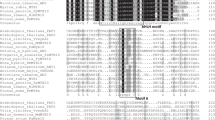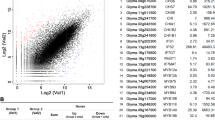Abstract
Main conclusion
MiMYB1 and MibHLH2 play key roles in anthocyanin biosynthesis in Matthiola incana flowers. We established a transient expression system using Turnip mosaic virus vector in M. incana.
Abstract
Garden stock (Matthiola incana (L.) R. Br.) is a popular flowering plant observed from winter to spring in Japan. Here we observed that anthocyanin accumulation in ‘Vintage Lavender’ increased with flower development, whereas flavonol accumulation remained constant throughout flower development. We obtained five transcription factor genes, MiMYB1, MibHLH1, MibHLH2, MiWDR1, and MiWDR2, from M. incana floral cDNA contigs. Yeast two-hybrid analyses revealed that MiMYB1 interacted with MibHLH1, MibHLH2, and MiWDR1, but MiWDR2 did not interact with any transcription factor. Expression levels of MiMYB1 and MibHLH2 increased in petals during floral bud development. Their expression profiles correlated well with the temporal profiles of MiF3ʹH, MiDFR, MiANS, and Mi3GT transcripts and anthocyanin accumulation profile. On the other hand, MibHLH1 was expressed weakly in all organs of ‘Vintage Lavender’. However, high expression levels of MibHLH1 were detected in petals of other cultivars with higher levels of anthocyanin accumulation than ‘Vintage Lavender’. MiWDR1 and MiWDR2 maintained constant expression levels in petals during flower development and vegetative organs. Transient MiMYB1 expression in 1-month-old M. incana seedlings using a Turnip mosaic virus vector activated transcription of the endogenous anthocyanin biosynthetic genes MiF3ʹH, MiDFR, and MiANS and induced ectopic anthocyanin accumulation in leaves. Therefore, MiMYB1 possibly interacts with MibHLH2 and MiWDR1, and this trimeric protein complex activates the transcription of anthocyanin biosynthetic genes in M. incana flowers. Moreover, MibHLH1 acts as an enhancer of anthocyanin biosynthesis with the MiMYB1–MibHLH2–MiWDR1 complex. This study revealed the molecular mechanism involved in the regulation of anthocyanin accumulation levels in M. incana flowers.






Similar content being viewed by others
References
Allan AC, Espley RV (2018) MYBs drive novel consumer traits in fruits and vegetables. Trends Plant Sci 23:693–705. https://doi.org/10.1016/j.tplants.2018.06.001
Bedoya LC, Martinez F, Orzaez D, Daros JA (2012) Visual tracking of plant virus infection and movement using a reporter MYB transcription factor that activates anthocyanin biosynthesis. Plant Physiol 158:1130–1138. https://doi.org/10.1104/pp.111.192922
Bernhardt C, Lee MM, Gonzalez A, Zhang F, Lloyd A, Schiefelbein J (2003) The bHLH genes GLABRA3 (GL3) and ENHANCER OF GLABRA3 (EGL3) specify epidermal cell fate in the Arabidopsis root. Development 130:6431–6439. https://doi.org/10.1242/dev.00880
Chen D, Liu Y, Pan Q, Li FF, Zhang Q, Ge X, Li Z (2018) De novo transcriptome assembly, gene expressions and metabolites for flower color variation of two garden species in Brassicaceae. Sci Hortic 240:592–602. https://doi.org/10.1016/j.scienta.2018.06.057
Chiu LW, Zhou X, Burke S, Wu X, Prior RL, Li L (2010) The purple cauliflower arises from activation of a MYB transcription factor. Plant Physiol 154:1470–1480. https://doi.org/10.1104/pp.110.164160
Crane MB, Lawrence MB (1947) The genetics of garden plants. Macmillan & Co. Ltd, London, pp 50–54
Dole JM, Wilkins HF (2005) Matthiola. Floriculture prinples and species. Pearson Prentice Hall, New Jersey, pp 682–687
Dressel A, Hemleben V (2009) Transparent Testa Glabra 1 (TTG1) and TTG1-like genes in Matthiola incana R. Br. and related Brassicaceae and mutation in the WD-40 motif. Plant Biol 11:204–212. https://doi.org/10.1111/j.1438-8677.2008.00099.x
Forkmann G (1980) The B-ring hydroxylation pattern of intermediates of anthocyanin synthesis in pelargonidin- and cyanidin-producing lines of Matthiola incana. Planta 148:157–161. https://doi.org/10.1007/BF00386416
Forkmann G (1993) Genetics of flavonoids. In: Harborn JB (ed) The flavonoids: advances in research scince 1986. Chapman & Hall, London, pp 537–564
Grabherr MG, Haas BJ, Yassour M, Levin JZ, Thompson DA, Amit I, Adiconis X, Fan L, Raychowdhury R, Zeng Q, Chen Z, Mauceli E, Hacohen N, Gnirke A, Rhind N, di Palma F, Birren BW, Nusbaum C, Lindblad-Toh K, Friedman N, Regev A (2011) Full-length transcriptome assembly from RNA-seq data without a reference genome. Nat Biotechnol 29:644–652. https://doi.org/10.1038/nbt.1883
Hemleben V, Dressel A, Epping B, Lukacin R, Martens S, Austin M (2004) Characterization and structural features of a chalcone synthase mutation in a white-flowering line of Matthiola incana R. Br. (Brassicaceae). Plant Mol Biol 55:455–465. https://doi.org/10.1007/s11103-004-1125-y
Hisamatsu T, Koshioka M, Kubota S, Fujime Y, King RW, Mander LN (2000) The role of gibberellin biosynthesis in the control of growth and flowering in Matthiola incana. Physiol Plant 109:97–105. https://doi.org/10.1034/j.1399-3054.2000.100114.x
Kamada K, Omata S, Yamagishi N, Kasajima I, Yoshikawa N (2018) Gentian (Gentiana triflora) prevents transmission of apple latent spherical virus (ALSV) vector to progeny seeds. Planta 248:1431–1441. https://doi.org/10.1007/s00425-018-2992-9
Li X, Chen L, Hong M, Zhang Y, Zu F, Wen J, Yi B, Ma C, Shen J, Tu J, Fu T (2012) A large insertion in bHLH transcription factor BrTT8 resulting in yellow seed coat in Brassica rapa. PLoS ONE 7:e44145. https://doi.org/10.1371/journal.pone.0044145
Lim SH, Song JH, Kim DH, Kim JK, Lee JY, Kim YM, Ha SH (2016) Activation of anthocyanin biosynthesis by expression of the radish R2R3-MYB transcription factor gene RsMYB1. Plant Cell Rep 35:641–653. https://doi.org/10.1007/s00299-015-1909-3
Lim SH, Kim DH, Kim JK, Lee JY, Ha SH (2017) A radish basic Helix-Loop-Helix transcription factor, RsTT8 acts a positive regulator for anthocyanin biosynthesis. Front Plant Sci 8:1917. https://doi.org/10.3389/fpls.2017.01917
Llorente B, Torres-Montilla S, Morelli L, Florez-Sarasa I, Ezquerro M, D’andrea L, Majer E, Troncoso A, Fernie AR, Daròs JA, Rodriguez-Concepcion M (2019) Synthetic biogenesis of chromoplasts from leaf chloroplasts. bioRxive 819177. https://doi.org/10.1101/819177
Mortimer CL, Dugdale B, Dale JL (2015) Updates in inducible transgene expression using viral vectors: from transient to stable expression. Curr Opin Biotechnol 32:85–92. https://doi.org/10.1016/j.copbio.2014.11.009
Nakatsuka T, Koishi K (2018) Molecular characterization of a double-flower mutation in Matthiola incana. Plant Sci 268:39–46. https://doi.org/10.1016/j.plantsci.2017.12.009
Nakatsuka T, Nishihara M, Mishiba K, Yamamura S (2005) Temporal expression of flavonoid biosynthesis-related genes regulates flower pigmentation in gentian plants. Plant Sci 168:1309–1318. https://doi.org/10.1016/j.plantsci.2005.01.009
Nakatsuka T, Haruta KS, Pitaksutheepong C, Abe Y, Kakizaki Y, Yamamoto K, Shimada N, Yamamura S, Nishihara M (2008) Identification and characterization of R2R3-MYB and bHLH transcription factors regulating anthocyanin biosynthesis in gentian flowers. Plant Cell Physiol 49:1818–1829. https://doi.org/10.1093/pcp/pcn163
Nakatsuka T, Sasaki N, Nishihara M (2014) Transcriptional regulators of flavonoid biosynthesis and their application to flower color modification in Japanese gentians. Plant Biotechnol 31:389–399. https://doi.org/10.5511/plantbiotechnology.14.0731a
Nakatsuka T, Suzuki T, Harada K, Kobayashi Y, Dohra H, Ohno H (2019) Floral organ- and temperature-dependent regulation of anthocyanin biosynthesis in Cymbidium hybrid flowers. Plant Sci 287:110173. https://doi.org/10.1016/j.plantsci.2019.110173
Nesi N, Jond C, Debeaujon I, Caboche M, Lepiniec L (2001) The Arabidopsis TT2 gene encodes an R2R3 MYB domain protein that acts as a key determinant for proanthocyanidin accumulation in developing seed. Plant Cell 13:2099–2114. https://doi.org/10.1105/tpc.010098
Quattrocchio F, Wing JF, Leppen H, Mol J, Koes RE (1993) Regulatory genes controlling anthocyanin pigmentation are functionally conserved among plant species and have distinct sets of target genes. Plant Cell 5:1497–1512. https://doi.org/10.1105/tpc.5.11.1497
Rail S, Hemleben V (1984) Characterization and expression of chalcone synthase in different genotypes of Matthiola incana R.Br. during flower development. Plant Mol Biol 3:137–145. https://doi.org/10.1007/BF00016061
Ramsay NA, Walker AR, Mooney M, Gray JC (2003) Two basic-helix-loop-helix genes (MYC-146 and GL3) from Arabidopsis can activate anthocyanin biosynthesis in a white-flowered Matthiola incana mutant. Plant Mol Biol 52:679–688. https://doi.org/10.1023/a:1024852021124
Saito N, Tatsuzawa F, Nishiyama A, Yokoi M, Shigihara A, Honda T (1995) Acylated cyanidin 3-sambubioside-5-glucosides in Matthiola incana. Phytochemistry 38:1027–1032. https://doi.org/10.1016/j.phytochem.2006.05.001
Saito K, Yonekura-Sakakibara K, Nakabayashi R, Higashi Y, Yamazaki M, Tohge T, Fernie AR (2013) The flavonoid biosynthetic pathway in Arabidopsis: structural and genetic diversity. Plant Physiol Biochem 72:21–34. https://doi.org/10.1016/j.plaphy.2013.02.001
Sánchez F, Martinez-Herrera D, Aguilar I, Ponz F (1998) Infectivity of turnip mosaic potyvirus cDNA clones and transcripts on the systemic host Arabidopsis thaliana and local lesion hosts. Virus Res 55:207–219. https://doi.org/10.1016/S0168-1702(98)00049-5
Sasaki K, Mitsuda N, Nashima K, Kishimoto K, Katayose Y, Kanamori H, Ohmiya A (2017) Generation of expressed sequence tags for discovery of genes responsible for floral traits of Chrysanthemum morifolium by next-generation sequencing technology. BMC Genomics 18:683. https://doi.org/10.1186/s12864-017-4061-3
Saunders ER (1928) Matthiola. Bibliographia. Genetica 4:141–170
Seyffert W (1971) Simulation of quantitative characters by genes with biochemically definable action. Theoret Appl Genetics 41:285–291. https://doi.org/10.1007/BF00277333
Spribille R, Forkmann G (1981) Genetic control of chalcone synthase activity in flowers of Matthiola incana R. Br. Z Naturforsch 36C:619–624
Suzuki K, Suzuki T, Nakatsuka T, Dohra H, Yamagishi M, Matsuyama K, Matsuura H (2016) RNA-seq-based evaluation of bicolor tepal pigmentation in Asiatic hybrid lilies (Lilium spp.). BMC Genomics 17:611. https://doi.org/10.1186/s12864-016-2995-5
Tatsuzawa F, Saito N, Toki K, Shinoda K, Honda T (2012) Flower colors and their anthocyanins in Matthiola incana cultivars (Brassicaceae). J Jpn Soc Hort Sci 81:91–100. https://doi.org/10.2503/jjshs1.81.91
Tatsuzawa F, Okuyama N, Kato K, Shono H, Takeda J, Kofujita H (2014) Sinapoylglucoside and kaempferol glycosides in flowers of Matthiola incana cultivars (Brassicaceae). Hort Res (Japan) 13:85–89. https://doi.org/10.2503/hrj.13.85. (In Japanese with English abstract)
Teusch M, Forkmann G, Seyffert W (1986) Genetic control of UDP-glucose: anthocyanin 5-O-glucosyltransferase from flowers of Matthiola incana R.Br. Planta 168:586–591. https://doi.org/10.1007/BF00392280
Teusch M, Forkmann G, Seyffert W (1987) Genetic control of hydroxycinnamoyl-coenzyme a: anthocyanidin 3-glycoside-hydroxycinnamoyltransferase from petals of Matthiola incana. Phytochemistry 26:991–994. https://doi.org/10.1016/S0031-9422(00)82333-X
Thole V, Worland B, Snape JW, Vain P (2007) The pCLEAN dual binary vector system for Agrobacterium-mediated plant transformation. Plant Physiol 145:1211–1219. https://doi.org/10.1104/pp.107.108563
Tian J, Pei H, Zhang S, Chen J, Chen W, Yang R, Meng Y, You J, Gao J, Ma N (2014) TRV-GFP: a modified Tobacco rattle virus vector for efficient and visualizable analysis of gene function. J Exp Bot 65:311–322. https://doi.org/10.1093/jxb/ert381
Wei YL, Li JN, Lu J, Tang ZL, Pu DC, Chai YR (2007) Molecular cloning of Brassica napus TRANSPARENT TESTA 2 gene family encoding potential MYB regulatory proteins of proanthocyanidin biosynthesis. Mol Biol Rep 34:105–120. https://doi.org/10.1007/s11033-006-9024-8
Xu W, Dubos C, Lepiniec L (2015) Transcriptional control of flavonoid biosynthesis by MYB-bHLH-WDR complexes. Trends Plant Sci 20:176–185. https://doi.org/10.1016/j.tplants.2014.12.001
Yang X, Lu Y, Zhao X, Jiang L, Xu S, Peng J, Zheng H, Lin L, Wu Y, MacFarlane S, Chen J, Yan F (2019) Downregulation of nuclear protein H2B induces salicylic acid mediated defense against PVX infection in Nicotiana benthamiana. Front Microbiol 10:1000. https://doi.org/10.3389/fmicb.2019.01000
Yuan Y, Chiu LW, Li L (2009) Transcriptional regulation of anthocyanin biosynthesis in red cabbage. Planta 230:1141–1153. https://doi.org/10.1007/s00425-009-1013-4
Zhang F, Gonzalez A, Zhao M, Payne CT, Lloyd A (2003) A network of redundant bHLH proteins functions in all TTG1-dependent pathways of Arabidopsis. Development 130:4859–4869. https://doi.org/10.1242/dev.00681
Zhang B, Hu Z, Zhang Y, Li Y, Zhou S, Chen G (2012) A putative functional MYB transcription factor induced by low temperature regulates anthocyanin biosynthesis in purple kale (Brassica Oleracea var. acephala f. tricolor). Plant Cell Rep 31:281–289. https://doi.org/10.1007/s00299-011-1162-3
Zhao D, Jiang Y, Ning C, Meng J, Lin S, Ding W, Tao J (2014) Transcriptome sequencing of a chimaera reveals coordinated expression of anthocyanin biosynthetic genes mediating yellow formation in herbaceous peony (Paeonia lactiflora Pall.). BMC Genomics 15:689. https://doi.org/10.1186/1471-2164-15-689
Acknowledgements
We thank Ms. Nobue Nakamura, Shizuoka University, for technical support. This work was supported by JSPS KAKENHI Grant Number 17H03765 and Ministerio de Ciencia, Innovación y Universidades (Spain; co-financed European Union FEDER funds) Grant BIO2017-83184-R.
Author information
Authors and Affiliations
Corresponding author
Ethics declarations
Conflict of interest
The authors declare that they have no conflict of interest.
Additional information
Publisher's Note
Springer Nature remains neutral with regard to jurisdictional claims in published maps and institutional affiliations.
Electronic supplementary material
Below is the link to the electronic supplementary material.
425_2020_3351_MOESM1_ESM.pdf
Supplementary file1 Supplementary Fig. S1 Chromatographs of anthocyanins, flavonols, and hydrolytic aglycones extracted from Matthiola incana ‘Vintage Lavender’. Flavonoids extracted from petals at stage S4 were separated using HPLC and monitored at 520 nm (a) and 360 nm (b). Two major peaks detected at 520 nm were annotated as (1) cyanidin 3-[2-(2-(sinapoyl)-xylosyl)-6-(p-coumaroyl)-glucoside]-5-[6-(malonyl)-glucoside] and (2) cyanidin 3-[2-(2-(sinapoyl)-xylosyl)-6-(feruloyl)-glucoside]-5-[6-(malonyl)-glucoside]. Three major peaks detected at 360 nm were annotated as (3) 1-(sinapoyl)-glucopyranoside, (4) kaempferol 3-(2-rhamnopyranosyl)-β-glucopyranoside-7-rhamnopyranosid, and (5) kaempferol 3--(2-rhamnopyranosyl)-arabinopyranoside-7-rhamnopyranoside. The hydrolyzed extracts collected from ‘Vintage Lavender’ petals were monitored at 530 nm (c) and 360 nm (d), respectively. (e and f) Chromatographs of standards, cyanidin (Cy), delphinidin (Dp), pelargonidin (Pg), kaempferol (K), quercetin (Q), and myricetin (M). (PDF 1649 kb)
425_2020_3351_MOESM2_ESM.pdf
Supplementary file2 Supplementary Fig. S2 Phylogenetic tree inferred from the amino acid sequences of the R2R3 region of MiMYBs with R2R3-MYB from other species. This phylogenetic tree was constructed using the neighbor-joining method with 1,000 bootstrapping data sets. R2R3-MYB name and GenBank accession numbers are as follows: Arabidopsis thaliana MYB11 (NP_191820), MYB12 (O22264), MYB111 (NP_199744), MYB113 (NP_176811), MYB114 (NP_176812), PAP1 (Q9FE25), PAP2 (Q9ZTC3), and TT2 (Q9FJA2); cauliflower (Brassica oleracea var. botrytis) BoMYB2 (ADP76651); garden stock (Matthiola incana) MiMYB1 (present study, red closed circle); grape (Vitis vinifera) MYBA1-1 (Q8L5P3); Japanese gentian (Gentiana triflora) MYB3 (A9ZMI4); petunia (Petunia hybrida) AN2 (Q9M72); maize (Zea mays) C1 (P10290) and P1 (P27898); snapdragon (Antirrhinum majus) MIXTA (Q38739), ROSEA1 (ABB83826), ROSEA2 (ABB8327), and VENOSA (ABB83828); and radish (Raphanus sativus) RsMYB1 (AKM95888). Scale bar represents 0.1 substitutions per site. (PDF 59 kb)
425_2020_3351_MOESM3_ESM.pdf
Supplementary file3 Supplementary Fig. S3 Phylogenetic tree inferred from the amino acid sequences of bHLH derived from Matthiola incana and other species. This phylogenetic tree was constructed using the neighbor-joining method with 1,000 bootstrapping data sets. bHLH name and GenBank accession numbers are as follows: snapdragon (Antirrhinum majus) delila (Q38736); Arabidopsis thaliana MYC1 (Q8W2F1), EGL3 (Q9CAD0), GL3 (Q9FN69), and TT8 (Q9FT81); cauliflower (Brassica oleracea var. botrytis) BoTT8 (ADP76654); garden stock (M. incana) MibHLH1 and MibHLH2 (present study, red closed circles); Japanese gentian (Gentiana triflora) bHLH1 (B7XEI1), gerbera (Gerbera hybrida) GMYC1 (O82686); maize (Zea mays) In1 (Q41875) and Lc (P13526); morning glory (Ipomoea nil) bHLH1 (Q1JV08), bHLH2 (Q1JV07), and bHLH3 (Q1JV06); rice (Oryza sativa) Ra (Q40643) and Rc (Q2I7J3); perilla (Perilla frutescens) F3G1 (Q852P3) and MYC-RP (Q9ZQS4); petunia (Petunia hybrida) AN1 (Q9FEA1) and JAF13 (O64908); and radish (Raphanus sativus) RsTT8 (ASF79354). Scale bar represents 0.1 substitutions per site. (PDF 60 kb)
425_2020_3351_MOESM4_ESM.pdf
Supplementary file4 Supplementary Fig. S4 Phylogenetic tree inferred from the amino acid sequences of WDR derived from Matthiola incana and other species. This phylogenetic tree was constructed using the neighbor-joining method with 1,000 bootstrapping data sets. WDR name and GenBank accession number are as follows: Arabidopsis thaliana AtAN11 (AAC18912.1) and AtTTG1 (NP_001318637); garden stock (M. incana) MiWDR1 and MiWDR2 (present study, red closed circles); morning glory (Ipomoea nil) InTTG1 (XP_019200425) and InWDR1 (BAE94407); perilla (Perilla frutescen) PFWD (BAB58883); petunia (Petunia hybrida) AN11 (AAC18914); and maize (Zea may) MP1 (NP_001169326) and PAC1 (NP_001310302). (PDF 57 kb)
425_2020_3351_MOESM5_ESM.pdf
Supplementary file5 Supplementary Fig. S5 Transient expression of MiMYB1 in Nicotiana benthamiana. a) The expression levels of transgenes were measured by RT-qPCR. Total RNA was isolated from the inoculated leaves of 7 days after inoculation. The expression levels of TuMVUK1, GFP, and MiMYB1 were normalized using that of NtUBQ-C. Values and error bars are expressed as mean ± standard error (n = 5). b) Anthocyanin amounts in TuMVUK1:GFP- and TuMVUK1:MiMYB1-infected N. benthamiana leaves. Anthocyanins were extracted from inoculated leaves at 7 days per inoculation (n = 10). N.D. indicates not detected. ns indicates no significant difference between TuMV:GFP and TuMV:MYB1 using Student’s t-test (P < 0.05). (c-d) N. benthamiana leaves at 15 days after inoculation with TuMVUK1:MiMYB1/GV3101 (c) and TuMVUK1:GFP/GV3101 (d). e) GFP fluorescence was observed in TuMVUK1:GFP-infected leaves under blue light. Bar = 1 cm. (PDF 103 kb)
425_2020_3351_MOESM6_ESM.pdf
Supplementary file6 Supplementary Fig. S6 Anthocyanin analysis of TuMV-infected Matthiola incana plants. Anthocyanins extracted from the upper leaves at 15 days after sap inoculation were monitored at a wavelength of 520 nm. The chromatographs of extracts from TuMVUK1:MiMYB1- and TuMVUK1:GFP-infected plants indicated as red and black lines, respectively. (PDF 169 kb)
Rights and permissions
About this article
Cite this article
Nuraini, L., Ando, Y., Kawai, K. et al. Anthocyanin regulatory and structural genes associated with violet flower color of Matthiola incana. Planta 251, 61 (2020). https://doi.org/10.1007/s00425-020-03351-z
Received:
Accepted:
Published:
DOI: https://doi.org/10.1007/s00425-020-03351-z




